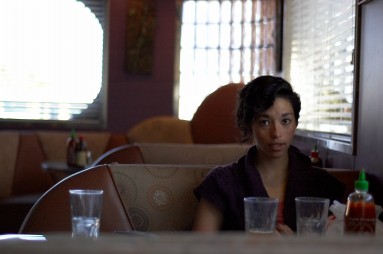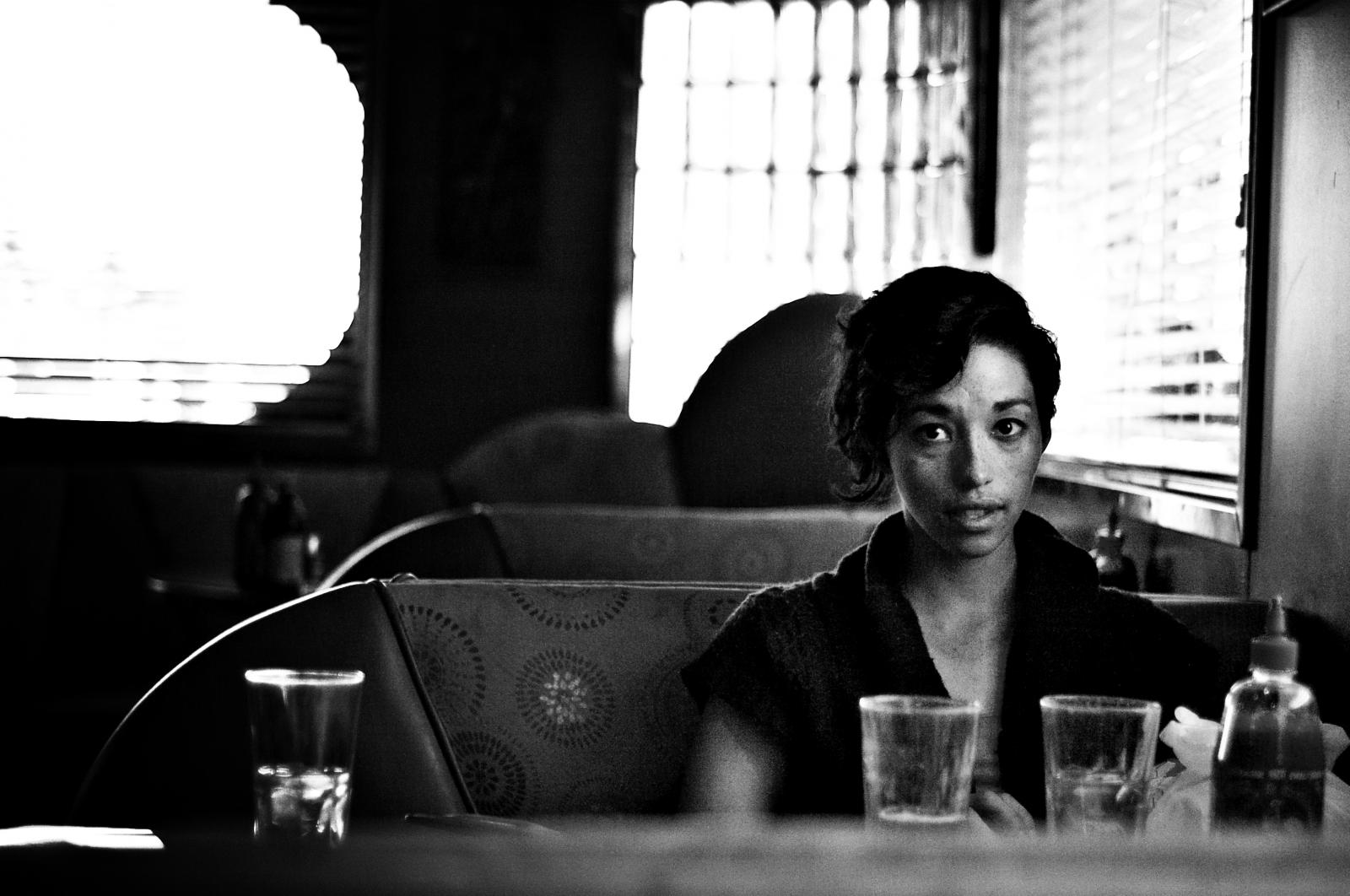There’s a photograph in my living room that I took three years ago in a Vietnamese diner in Vegas. It’s of a girl I used to see, but do not think about anymore. It’s in black and white, and she’s crowded to the right side of the frame, eyes fixed on the lens, lips hanging open a little. I remember the moment I took it. It was an hour before I left, a preamble to a goodbye. I liked the empty diner, the way the light piled over the side of her strange and pretty face, the way she decided not to pose or fix a smile. Whether it’s because she trusted me or because I was about to leave — I don’t know. But it was beautiful.
A good image is created in a state of grace, the late photographer Sergio Larrain said. I remember looking at the image on Photoshop when I got home and realizing grace was underexposed and then adding a vignette and stripping out all the color and cranking up the contrast to make grace presentable. It was the perfect moment but not the perfect photograph. Grace needed fakery to become graceful.
Fakery has always propped up photography in our untidy pursuit of glamor, from posing shots to skullduggery in the developing room. But the fakery is easier now than it used to be, and more of us now know how to do it. Anybody knows you can make skin smoother and darks brighter and hips slimmer and unnatural colors steep the whole body of the shot. It’s only a little lesser known that now you can do it cheaper and faster and more fraudulently than ever.
Actually, it’s a coup; you no longer need high-altitude software like Photoshop like I did, no longer need expensive hardware to crash photography’s beauty party. This is the final stage of a revolution, the democratization of what used to be professional photography, and its hippest, most boring propagandists use Hipstamatic and Instagram. Never before have we so rampantly exercised the ability to capture the way the world really looks and then so gorgeously disfigured it.
They’re all over Twitter and Facebook, vignetted to death, the blacks washed into purples or reds like old Polaroids. iPhones shoot with a rectangular frame, but the software chops it down to a square and slaps an arbitrarily aged border on the photo. It takes only a second, and that is perhaps the worst thing you can say about it, because it means anybody can do it. The more popular it gets, the tackier it will become.
Why? Because. Because Hipstamatic/Instagram manufacture decay. Because it’s what you get when people with money and taste are bored by reality; money because you need a smartphone or iPad with Internet to properly use Hipsta/gram; taste because no fool would deliberately age a photograph without ulterior aesthetic motives; bored because why else would you need to dramatically modify photographs of the Brooklyn Bridge, the beach, your beautiful friends?
In the endless game of tastemaking keepaway, when the going gets hip, the hip get simple. In a cheeky 1951 manifesto in The Journal of Aesthetics and Art Criticism, Robert L. Steiner and Joseph Weiss grappled with a peculiarity of cultural snobbery that reads like a bogus trend out of New York Times’ Style section. The snobs they dissected, a burgeoning upper-middle class fresh into the postwar boom years, now had the spending power to live like gods; the ostentatious ultra-rich, faced with a leveling economic playing field, had fewer ways to distance themselves from the upstarts — except to engage in spectacular acts of “counter-snobbery”:
About to be beaten at his old game of conspicuous consumption, the old elite summoned all the power of his waning prestige to effect a most remarkable reversal in the canons of honorific social conduct. … If an adulation of wealth is now an impotent weapon [to keep the arrivistes at bay], perhaps a mocking of wealth will prove a powerful one. As a result of the long practice of conspicuous consumption, ornate objects have become associated in the common mind with vast wealth. Therefore, if the old elite is to demonstrate a disinterest in money, it must deplore ornateness and adore simplicity.
If photography becomes faddishly ornate, as Hipsta/gram is making it, then counter-snobbery predicts that tasteful photographers, the elites, will become modest purists.
As a result, it's become much harder to separate the professional and the arriviste. It became harder to justify shoots and prints costing hundreds or thousands of dollars when there was an aunt in the family who futzed around a bit with a Nikon and had a pirated version of Photoshop.
I am that aunt. My father is a professional portrait photographer, and I got my start in photography by permanently “borrowing” a D200 from his studio. I never took lessons; I barely studied. But it was easy enough to figure out. I already know that I will likely never pay someone to take a photo for me again, just as the arrival of journalist - replacing iPhones and free downloads of Hipstamatic and Instagram mean that I, too, am ever less likely to get paid. The work of photography once belonged exclusively to laborers. Now it belongs to everybody, it belongs to me, and someday I will put my father out of business forever because of it.
***
The cosmic significance of Hipsta/gram is not physical. It ages digital photos for distribution in a digital world. But nothing really gets older online; the only aging of things here comes from the erosive force of changing human sensibilities. The black of that North Face jacket looks just as black, but the point of wearing it has faded a little. Here there is only the appearance of getting older because everything else has gotten much newer. The pixels do not outwardly become worn. They are like grains of sand. If one is destroyed, it's too small for us to know it's been annihilated. And there is so much sand.
The Nikon I stole from my father has made beaches of it. It’s been to three continents, a revolution and a few natural disasters. It's also been down pointless alleys in Kansas City and to a few family birthday parties and some other things I wouldn’t remember if I hadn’t photographed them. It still shoots, and I don't worry about whether it will shoot when I want it to shoot: It’ll shoot.
But eventually the D200 will break or be seized or I will damage it to annoyance or my editors will ask I shoot video or in 3D or in smellovision. And I'll do it.
But I have an attachment to this heavy knuckle of metal and plastic, because it’s been through a lot with me, and this attachment is beyond stupid and simply tragic. It’s a physical object that moves and bumps about in a world of physical things, and eventually it will break down just as my body will break down, the same as it produced a physical print on my wall that will age just as the girl in it has aged. We will all be insulted by time together; just not online. Those blacks will still be black if they were always black.
***

Every picture you upload, every cheap memory tweeted from your friend’s backyard into digital eternity, is also tied to some tendon or ankle of hardware in a faraway warehouse that corporate security would never let you enter. This is risk. Someday these places will be destroyed — by bombs, by cranes, by floods, by history, by all the kinds of things we tend to photograph — and the images will be gone if they're not also fastened to the world somewhere else.[l]Disks warp, hard drives corrupt, formats change. Oblivion is not as far off as you think. Eleven percent of images, tweets, videos and links from the 2011 Egyptian revolution have disappeared just a year later, according to a sample of social media examined by Hany SalahEldeen, an Egyptian and a PhD student who studies Web preservation at Old Dominion University. If that pace continued, he wrote, "in less than 10 years there will be no story to tell for the future generations."[/l]Perhaps you'll care; perhaps you're dead by then and won't. Perhaps your children will care if they're neurotic enough to scrutinize your history by sorting through 50 photographs from a hayride you never thought about again; perhaps they won’t.
Think of this from 50 years out, if you care. Hipstamatic and Instagram’s distortion of reality may eventually become annoying beyond faddishness and ascend to historical obnoxiousness; there's even one filter that slaps a 30-year-old date on the photo it warps. The chasm they leap so instantly between reality and artificial antiquity — and the fact that it’s the latter that’ll be preserved for and remembered by posterity — makes me think of Borges’ wry declaration: “The original is unfaithful to the translation.” The past won’t be what it used to be. But Borges is gone.
Borges once wrote a story about a boy named Funes who remembered everything, like a human camera, and by the end of the story, Funes was gone. If anything, I like having this gussied photograph in my living room aging with me because I don’t know the next time I’ll get one printed. The idea of a having a print already comes from an era I no longer live in; tomorrow I’ll just log on to Facebook to see the photos of my newer friends. They’re fixed to a wall of a different kind, hung in a different kind of living room, but one also accumulating the detritus of lives headed in unknown directions. We are no less alive because of it, the technology bent to no less human purposes. I feel something more than nothing when I wake to images of those strange new friends in Cairo I’d had no right to meet let alone see again, but that’s as much a commentary on the business of picture-making as it on fate.
So perhaps that’s really it: Our interesting times have met a golden age of photography. Fathom the tiny lens of an iPhone, powerful enough to depose our dictators and break our hearts in an instant. Such a strange fate for an art, Borges might’ve thought. But still no stranger than our own.

